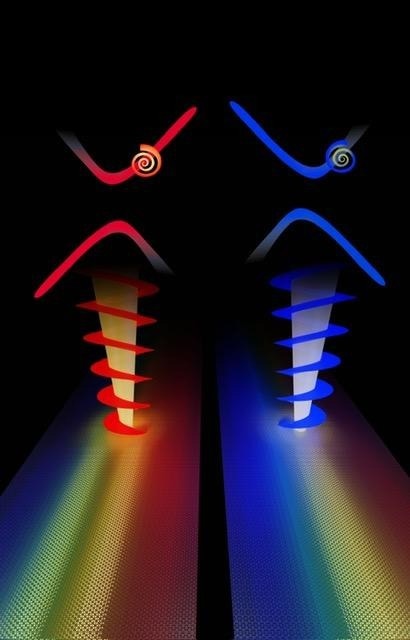Everyone encounters optical rays or beams, one of light’s purest forms, daily. Light may, however, take on much stranger shapes. As a result, even beams can be bent to resemble spirals; these are known as vortex beams and have peculiar features. Dust particles can spin when exposed to such beams, just as they do while traveling down some fictitious spirals.
 Channels for guiding structured light—a prototype of silicon photonic chip with information encoded in the spinning structure of optical mode. Image Credit: Svetlana Kiriushechkina
Channels for guiding structured light—a prototype of silicon photonic chip with information encoded in the spinning structure of optical mode. Image Credit: Svetlana Kiriushechkina
“Structured” light modes are those that have this additional structure, and even more unusual types of structured light can be produced in metamaterials, which are artificial optical materials where multiple light waves interact to produce the most intricate forms of light.
Researchers from Alexander Khanikaev’s group at City College of New York created structured light on a silicon chip in their most recent two publications, which were published back-to-back in the prestigious journals Science Advances and Nature Nanotechnology. They used this added structure to achieve new functionalities and control that were not previously possible.
Two-dimensional optical metamaterials, known as metasurfaces, were developed to achieve this goal. These materials contain a unique type of structured light that spins about like vortex beams. An innovative type of trap to confine structured optical modes and direct them on the chip was proven by tests done in Khanikaev’s group at The City College.
Researchers demonstrate in their Science Advances article how one can create optical resonators that capture and emit structured light by gradually altering the layout of the metasurface in two directions. Interestingly, the optical vortex beams that resulted from this underlying structure were uncommon light emission patterns.
Researchers have developed waveguided for structured light by employing a similar modest shift in the pattern in one direction as described in Nature Nanotechnology article. These channels enable optical signal steering while retaining light's inherent structure.
As a result, if we could create wires with two different flavors of charges, this would be similar to the flow of currents in wires.
An entirely new class of electronic devices, known as spintronic or valleytronic, was envisioned as a result of the surprising recent surge in interest in such currents in electronics. In such devices, spin or the valley of electrons, rather than the flow of charge alone, would convey messages, promising several benefits over traditional electronic devices.
The notion is similar to Khanikaev’s work, except light is used in place of electrons. Optics and photonics, in contrast to electronic systems, offer one key advantage: optical modes do not experience decoherence to the same extent as electrons, which might be crucial for quantum technologies.
Several factors make the Khanikaev group’s demonstrations applicable to quantum applications. To encode quantum information in the form of quantum bits, optical modes’ additional structure can be utilized. For transferring quantum information across distant systems, this information can subsequently be transferred on a chip or released into space.
The Khanikaev group is now striving to apply these concepts with quantum states of structured light and realize quantum logic in their photonic nanostructures, which is a step in the right direction.
Journal References:
- Chen, K., et al. (2023) Photonic Dirac cavities with spatially varying mass term. Science Advances. doi:10.1126/sciadv.abq4243.
- Kiriushechkina, S., et al. (2023) Spin-dependent properties of optical modes guided by adiabatic trapping potentials in photonic Dirac metasurfaces. Science Advances. doi:10.1038/s41565-023-01380-9.
Source: https://www.ccny.cuny.edu/